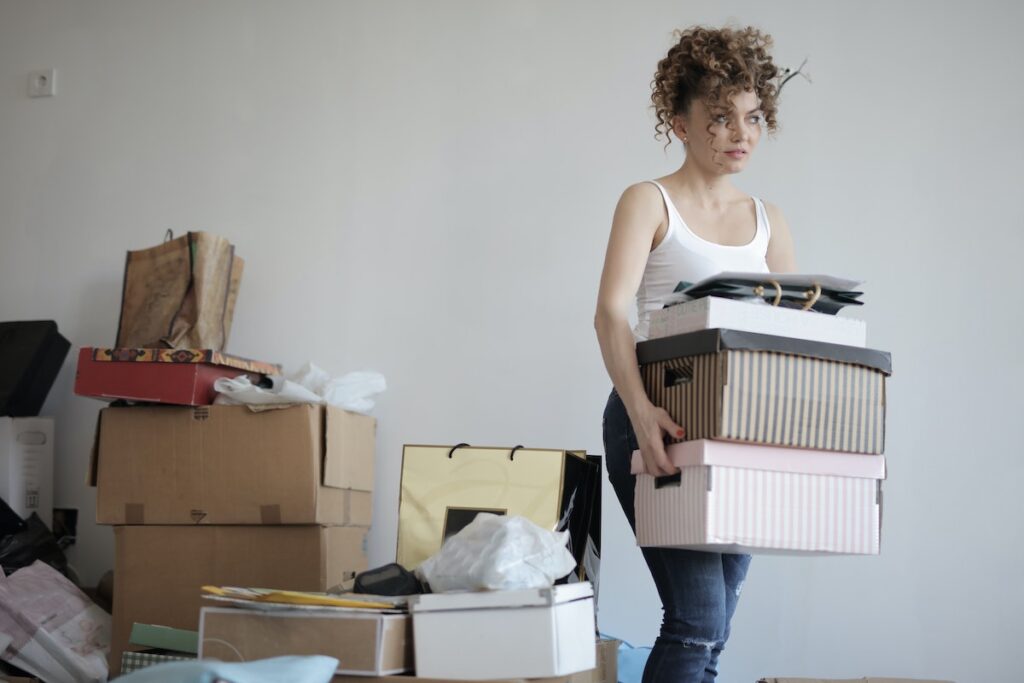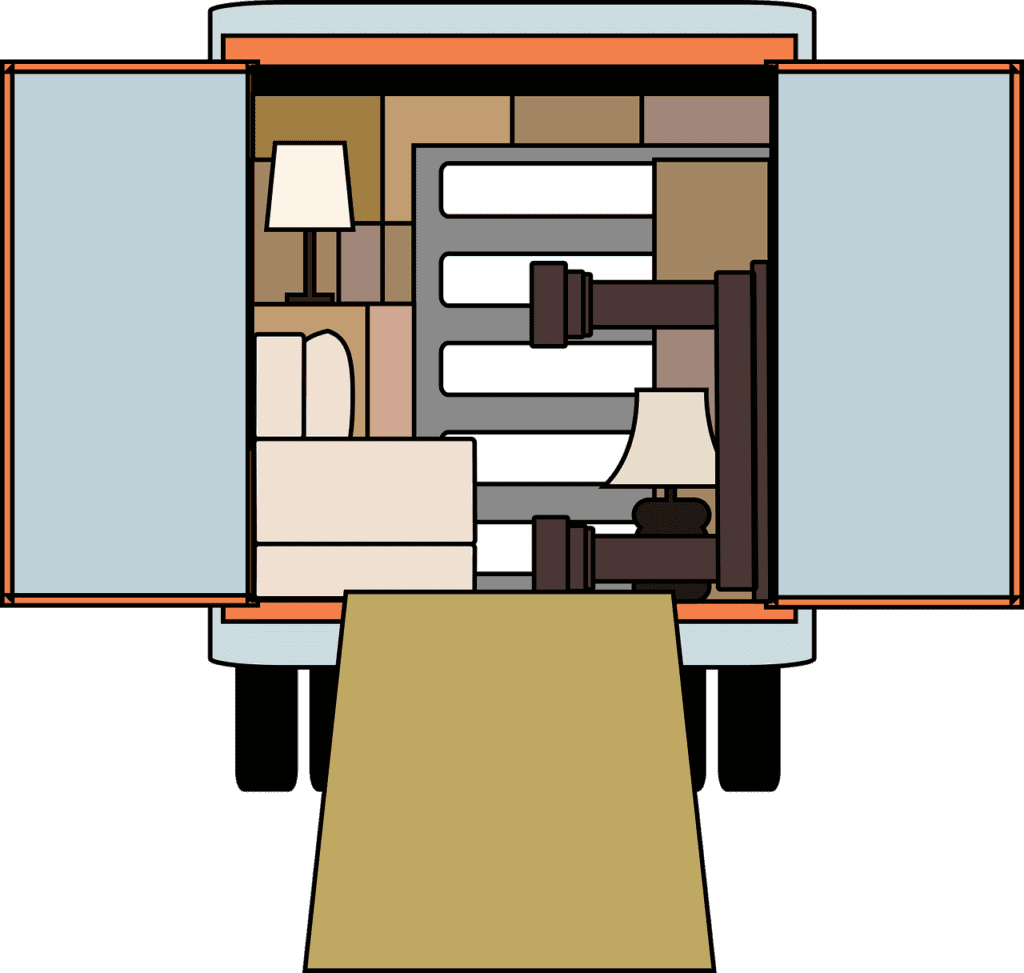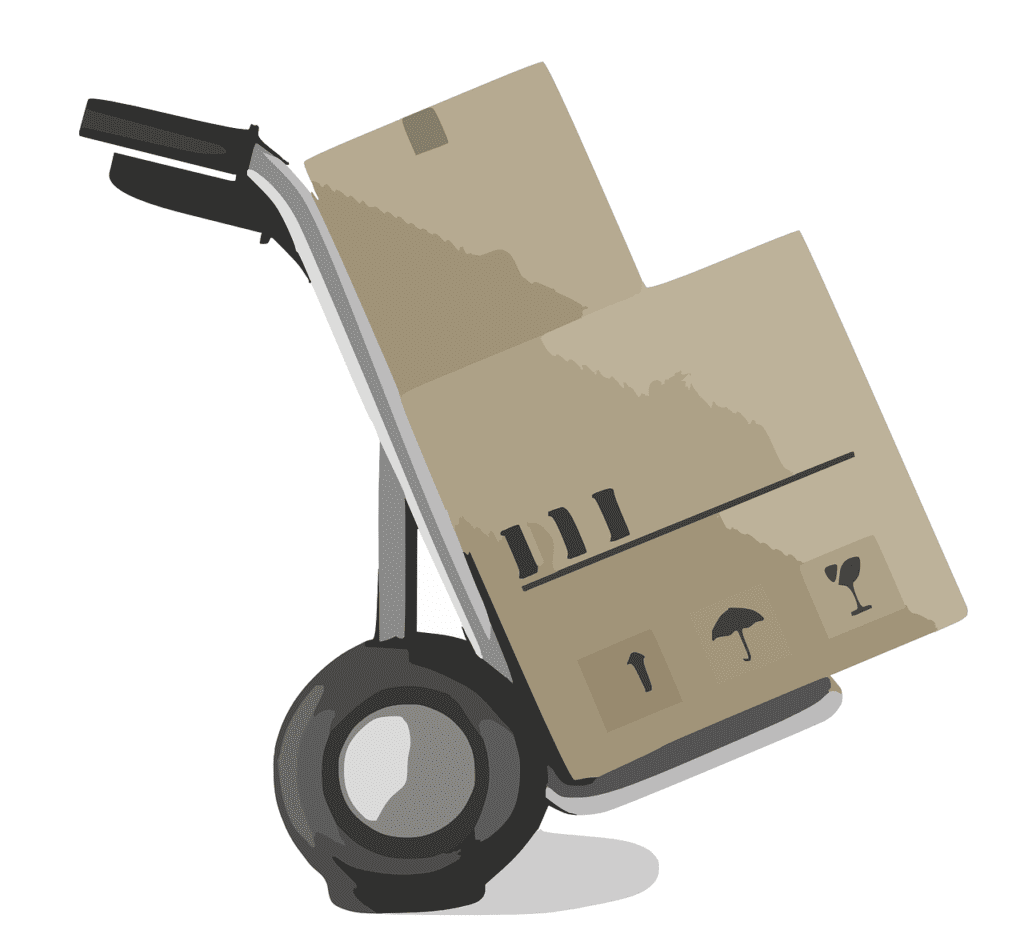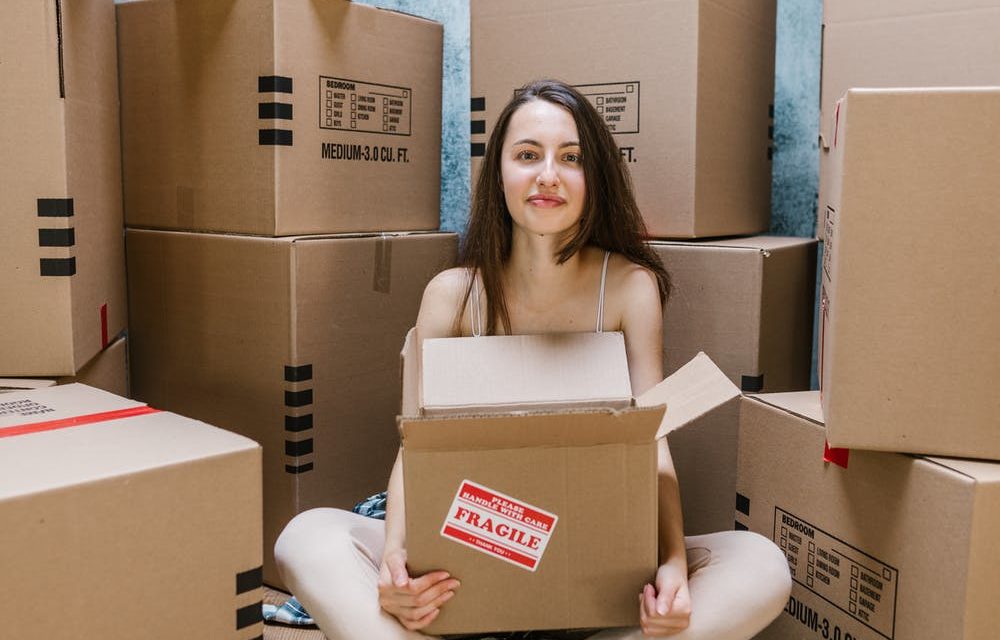You have decided to sell your house and move. The house is listed with a real estate agent and your thoughts are focused on the sale. Then you look at all of that stuff. Wow! What do we do with all of it? Your new place is smaller than your existing house. You have so much stuff that has accumulated over the years. I am going to walk you through the entire process having been through it many times. That moving checklist is only one part of the moving process. Use our 86 good tips on moving stuff to your new home checklist at the bottom of this article.
I strongly recommend that you start working on the move as soon as the ink is dry on your listing agreement. This will be the most emotional part of the entire relocation process. The big move will be looming large for weeks.
Unless the cost of moving is no problem because your company is paying, I suggest you reduce the number of items you are moving to reduce costs. You will have a couple of options. Hire professional movers or rent a moving truck.
A DIY move is the cheapest move
If your move is local, the moving truck and friends are the cheapest way, called a DIY move. If you are moving to the Mississippi Gulf Coast from California, the best way may be to hire a moving company. A Long-distance move when you have a large house of stuff may be your only option. I have done the cross-country move several times and it’s about as fun as going to the dentist.
35 Million people move each year in the U.S.
80% of all moves are within the same state the average household moves 1,200 miles New Jersey, New York, Illinois, connecticut and california experienced most moving out
If you are like me, wasting money is not an option. When you negotiate your final price to move (I will get into that shortly), your base price will be on a per-pound basis with “cube” being a factor as well. You understand the price per pound but the price per cube is based upon the space that items take. For example, shipping a standing safe will be high on a per-pound basis but low on a cube basis.
Shipping sofa pillows are expensive
Shipping sofa pillows one to a box is costly because they do not weigh much but take up space in the truck. It’s important that packing be done efficiently. Using every inch of space and reducing air space in boxes. If you can disassemble furniture such as a dining room table by taking your legs off, you will save money. If you do take things apart, be sure to tape the screws and bolts to the item but not on fabric such as leather or cloth.
You will pay a price per pound for professional movers
When you obtain your price per pound and then calculate the overall cost per pound, look at the items that you intend to move. You will find that the cost to move may be close to the cost to replace the item at the new location. Why move a 15-year-old lawnmower if the cost to move it is for example 80% of the cost of a new one? Leave it and buy one on sale at the new location.
When I moved from California to the Mississippi Gulf Coast, I gave away and donated many, many pounds of clothing and other items that I believed would not be used at my new destination. I saved thousands of dollars.
If you want to hoard worthless items, it will cost you. A friend moved to California (who has since left and moved to the Mississippi Gulf Coast) and rented storage space for furniture that would not fit into his apartment. He paid rent for five years (at a significant cost) to store those items which were from his previous house. Check out our tips about moving stuff.
Average Cost to Move Household Goods
| Distance | 1 Bedroom | 2-3 Bedrooms | 4-5 Bedrooms |
|---|---|---|---|
| 200 Miles | $200-$500 | $300-$700 | $400-$900 |
| 1000 Miles | $1000-$2000 | $1500-$3000 | $2000-$4000 |
| 2000 Miles | $2000-$4000 | $3000-$6000 | $4000-$8000 |
What can you live without
When they decided to move, they realized that most of the items were old and out of style or would not work at the new house. Yes, they gave it away along with the rent for five years. Think about what you can live with and not live with. That broken skateboard that your daughter used 10 years ago has probably seen its day.
That garage is problematic for many. I suggest you have a family member help you decide what to keep and what to sell at your yard sale or garage sale. Our daughter has held several garage sales so she set one up. She questioned almost everything we had to help cut the cord.
I knew the cost per pound and I agreed that some things would cost more to move than to buy new ones at the new location. The cost of your move will be much lower if you sell or give away or donate stuff you really don’t need. This is a great time to get organized.
If you are older and this is a retirement move, you really have to ask yourself if you need a lot of stuff in retirement. Your old home may be jammed with items that you have not used for a long time and may never use again. If you are moving to a condo, it’s time to sell the lawn mower.

Let a family member help sort your stuff
That old coffee table will be a crowd in the new house, let it go. Sell your old furniture, and buy new furniture at the new location. Perhaps it’s time for a new look.
Remember all of those unwanted items you bring along will have to be placed somewhere. A great way to reduce stress and cost is to let that family member cut ties between you and that old bed frame in the garage. Reduce the number of items you bring and that will reduce the work at the other end trying to jam it into a cabinet.
If while you are cleaning out the yard and garage you have lots of junk, arrange for junk removal or order a large bin from your trash hauler. Remember your trash cans are collected once per week and if you fill them where will you put that other junk? Old appliances can be collected by companies that do that for a living. Just be sure to arrange for all of this well before your moving date. Have plenty of plastic bags on hand for junk.

Packing, fun stuff
Your move may be paid for by your employer, so let them pack. I recall several times when my employer paid the cost of packing but we still spent hours working on sorting before they packed. I remember unpacking trash at my new destination. The Packers were so fast that they literally packed everything in sight. When I was younger, I had a task to pack the kitchen for some people who had paid the moving company that was paying me.
Without any training at all, I packed the contents of the refrigerator careful not to break the eggs. It never occurred to me (at age 16) that cheese, milk, and eggs should not be packed. I have no idea how that worked out.
Most people pack themselves with perhaps help from family or friends. I have had help in the past but usually, we started packing well in advance e.g. 30 days prior to the move, and just stacked boxes. This process while exhausting did let us know what we had been storing in the lower shelves of our kitchen cabinets.

I can’t find my popcorn maker
I thought that If we packed, my good stuff would survive the move. Not. I still can’t find my popcorn maker (my wife will not admit she gave it away). It’s time to give up that storage unit. Things placed in storage units are often forgotten. I know, been there, done that.
Let me jump into where to get the materials and continue this discussion on packing. FYI, never pack valuables for shipment. Take coins, jewelry, and valuable art with you or ship via UPS or FedEx insured. If you intend to drive to your new location, consider packing the trunk and back seat with clothing.
Take the items off the rack and lay them flat, they will take less space and you will have something to wear at the new location.
What to take along if you drive-Tips about moving stuff
You may consider not just driving to your new location but pulling a trailer or renting a small truck even when the bulk of items are shipped. This is a good idea if your household goods will not arrive for a while or your house is not ready and items have to go into storage. Consider taking the following:
- Assortment of tools; drill, hammer, pliers, etc. You may have projects before your garage items arrive
- Clothing. It’s far less expensive for you to take clothing, it weighs a lot and can lie flat in a car or truck.
- Pet items
- Personal items e.g. grooming, exercise e.g. scale, shoes, etc.
- Toilet paper for the new location along with paper towels
- Blow up beds if you need them along with linens for them
- Take your cleaning materials, the shipper will not permit you to ship them. You can spend lots of money replacing this item including garden chemicals (if you rent a truck or trailer, pack separately).
- Office documents if you work from home. Including personal files and important documents.
- Anything else to make life easier while waiting for the big shipment to arrive?
If you are doing a long-distance move, taking the above items may be necessary. Particularly the tools. I have moved many times and often forgot to take basic tools along to hang blinds, and do other things before the household items arrived.
I bought a used pick-up to move
Moving local, you can rent a truck or ask friends to move clothing and personal belongings to the new place. I have done this. One time I bought a used pick-up truck with an 8′ bed.
I bought one house with cash and we moved in while the other was still for sale. We made trips for about five weekends plus after work in the evenings. We hired local movers for the big stuff. This saved thousands of dollars. I sold the pick-up truck about three months later for more than I paid for it. This was a successful move.
Boxes, packing materials
Before you buy supplies take a look at our tips about moving stuff. Don’t buy cardboard boxes from the moving company. You can buy them at a lower cost from Home Depot or Lowes. Actually, if you live in a large metro area, go to a commercial packing materials company and buy boxes and bubble wrap and packing paper from them in large rolls. Buy a large pack of clear tape e.g. 6 or more rolls and a gun. Sams and Costco have good prices on packing tape and marking pens.
Consider buying blue painter’s tape to make large labels for furniture. Painters’ tape will peel right off without leaving any glue on the surface.
List of typical packing boxes
- Small box: 16″ x 12″ x 12″
- Medium box: 18″ x 18″ x 16″
- Large box: 18″ x 18″ x 24″
- Extra-large box: 24″ x 18″ x 24″
- Dish pack box: 18″ x 18″ x 28″
- Wardrobe box: 24″ x 24″ x 40″
- Mirror box: 40″ x 4″ x 30″
- Flat-panel TV box: varies depending on TV size
You will want to buy several different sizes. The smallest boxes I call book boxes. They can be used for heavy items such as forks, knives, and other utensils. You do not want to fill the larger boxes with heavy items, trust me. The larger size boxes can be used for clothing, linens, and bedding. Medium-sized boxes are good for kitchen items. Lowes has medium and heavy-duty boxes.
I use heavy-duty boxes for glass items such as kitchen bowls and decorations. They can better withstand being crushed. A great thing about buying these boxes from Lowes (see my comments below about Lowes) you can buy as many as you want and return what you do not use.
Buy a large roll of bubble wrap
I always buy a very large roll of bubble wrap. Sometimes they have a very large role at Lowes, other times I have found a paper goods supplier and purchased them. Don’t buy the small boxes from stationery stores, the cost per sheet is very high compared to the hardware stores’ pricing.
You will need markers, use black, they are easier to see. No need to get fancy. I always write the contents on two sides as you never know how they will come off the truck. Use paper to wrap plates to save space. The foam fills in corners and spaces. If you have large wall art, take a box that is larger than the art before it is folded and simply open it like an envelope.
Slip in the art and tape the top and bottom. Use foam if it has a glass front. Stack all of the art in the same place and direct the loaders to it as fragile.
Always wrap remote controls with tv items or tape the remotes to the back of the item. If you fail to do this, Murphy’s law kicks in and you will be looking for years for the correct remote. By the way, don’t pack your current garage door remote control, be kind and leave it for the new buyer.
How to work with Household Goods Movers
Practically the entire shipping industry works with brokers. Even when you call a large shipping company, they will probably use contractors to collect, pack and transport the goods to the new location. Sometimes they will also unload if your goods were not offloaded or warehoused along the way. Pricing is therefore very competitive.
Most of the largest companies will send a person to your home to give you a price. This usually ends up being the most accurate method of arriving at a final cost.
If you use an internet broker which I have in the past, don’t think for a second that you will save money if you “forget” to count boxes or list items for them to use in the estimate process. Your truck will drive over a scale at some point close to our home. That weight and not your count will be a factor in determining your final price. You will be provided with an inventory form to complete which they will use to create an estimate.
Your count can be wildly off base, either over or under, and somehow that weigh scale will bring things back to focus. The key issue here is to negotiate. Ask if you removed X what it would save or if you shipped X boxes less.

You must pay part of the cost when the driver arrives
Go back to my words above about items to take and how to pack. When the driver arrives, you must pay a large portion of the shipping costs at that time upwards of half of the estimate. The remainder will be due when the items are unloaded. Some shippers will take credit cards and some will charge you to use a card.
Do not settle with the first company. Obtain your first quote and then get another or three. Compare what they offer. If you have nothing serious in your household goods, consider not taking the insurance because you are already insured for a minimum amount.
Frankly, I think it is outrageous that they should offer any insurance because the idea is that you pay a professional to deliver your goods in good condition. Understand how insurance works. If for example they give you ten cents per pound insurance and you have 10,000 pounds of materials, they have a budget of $1,000 to repair or replace items. Beyond that, it’s your problem.
When the goods arrive, inspect everything. Let the shipper know at that time if there is a problem with an item. If you don’t find it for a few days, that’s ok. Follow their policy for reimbursement.
Back to the shipper. One shipper may have a better schedule meaning that the truck may arrive ahead of another. If your moving van is not completely filled, they will make stops at other locations. You can determine this by asking. I recall a movie where a ladder showed up at my house that must have belonged to the other party shipping at the same time.
Interim storage (in transit)
Should you require your goods to be stored for a period because your home will not be ready or for a variety of reasons, request that your goods be containerized when being packed at your home. The company will use large wooden crates and pack each crate.
The crates are sealed and removed then stacked for storage at a facility either at the shipping end or the receiving end. You want the crates because otherwise your goods will be handled individually two more times. Unloading and reloading for transport.
The additional handling may damage something. Chair legs and wood items get banged. Items get broken. This has happened to me everything my goods went into storage until I used a company that used containers. The company using containers delivered my goods just as they had been packed.
Frankly, I don’t trust the warehouse workers, things can go missing and the worker vanishes. So, reduce the number of times your goods are handled and exposed to strangers.
Other things – included in tips about moving stuff
Other items are all part of the move not the least of which involves your new destination. Before I forget, check up on the new buyers of our home, make sure they put utilities in their name and you get refunds if any, particularly from the insurance company. At the new destination, be sure your utilities are turned on before you arrive. The best thing is to arrange for the sellers to leave them on and you take charge of the account.
Otherwise, you may pay a new connection fee. You will want to find a home for all of those empty boxes. Check with a local church or not-for-profit organization. Don’t just throw them out. You can also sell them on Craig’s List or Marketplace.

Be sure you are signed up for trash service. You will have lots of packing materials to send off for recycling. Moving is a potentially stressful experience. Best to plan as far ahead as possible. Get everyone on the same page about what is going to happen and when. If this is a family move, assign tasks.
Thank you for reading this article and coming to RetireCoast.com. If you are thinking of relocating, give some thought to a move in my direction. The Mississippi Gulf Coast. I can help you find that home that will fit all of your furniture or simply find a home where you can buy new furniture. My wife and I moved to Ocean Springs a few years ago so the entire process is somewhat familiar. My real estate brokerage, Logan-Anderson, Gulf Coastal Realtors can help you find your new home.
Our Checklist- Tips about moving stuff
Moving Checklist – 87 Things to Consider
- Create a moving budget
- Get multiple moving quotes
- Research and choose a reputable moving company
- Compare cost of renting a truck vs a mover
- Ask friends to help pack to save money
- Check for labor or friends to help pack truck
- Decide on a moving date
- Give notice to your landlord or HOA
- Find a new place to live
- Measure your new home’s rooms and doorways
- Make a packing plan
- Sort items by category
- Ask family or friends to help with garage sale
- Declutter unwanted items
- Donate or sell items you no longer need
- Pack fragile items carefully
- Label boxes clearly
- Photograph fragile items before they are packed
- Use painters blue tape to label large items
- Pack home office and ship or transport important items
- Pack a first-day essentials box
- Pack non-essentials in advance
- Create an inventory list of all your items
- Take photos of valuable items before packing them
- Arrange for transportation of your vehicles
- Arrange to move boats and trailers
- Update your address with important contacts
- Contact utility companies to disconnect and reconnect services
- Transfer or cancel gym memberships and other subscriptions
- Transfer medical records to a new doctor
- Change your driver’s license and car registration to your new address
- Set up mail forwarding with the post office
- Cancel or transfer your lease or rental agreement
- Book elevators and parking spots for moving day
- Check if your new home has any moving restrictions or requirements
- Create a floor plan for your new home
- Pack a bag with important documents and valuables to carry with you
- Pack a bag with clothes and toiletries for the first few days in your new home
- Inform your employer of your move
- Notify your children’s school of your move
- Gather important medical records and prescriptions
- Pack an emergency kit
- Pack cleaning supplies for move-out and move-in
- Defrost and clean your refrigerator and freezer
- Drain any fuel or oil from lawn mowers or other outdoor equipment
- Dispose of hazardous materials
- Give away pesticides, herbicides etc. to neighbors
- Remove light bulbs from lamps and pack separately
- Wrap furniture with protective coverings
- Disassemble furniture as needed
- Pack electronics carefully with cords and accessories
- Label boxes with contents and destination room
- Pack books in small boxes to avoid heavy lifting
- Pack plates and dishes vertically with protective padding in between
- Pack clothing in wardrobe boxes or vacuum-sealed bags
- Pack jewelry and valuable items separately to carry with you
- Pack pet essentials and familiar items to reduce stress
- Arrange for pet transportation or boarding on moving day
- Arrange to clean the old house or apartment
- Repair holes in the walls and other damage
- Meet with real estate agent or landlord for inspection
- If renting ask for deposit back
- If selling, give keys to real estate agent
- Double-check all rooms and storage spaces for items left behind
- Make sure all boxes and furniture are loaded properly in the moving truck
- Arrive at new location
- Set up new home office
- Take photos of any damage to items or property during the move
- Confirm the delivery date and time with the moving company
- Be present during the unloading and unpacking process
- Check items off your inventory list as they are unloaded
- Inspect all items for damage and report any issues to the moving company
- Dispose of packing materials properly
- Donate empty boxes to Salvation Army
- Begin unpacking essentials first
- Set up utilities and internet/cable services
- Install and test smoke detectors and carbon monoxide detectors
- Install window coverings and curtains
- Set up furniture and appliances
- Hang pictures and decor
- Explore your new neighborhood and locate essential services
- Register to vote at your new address
- Update your car insurance policy with your new address
- Register for new library cards and other local memberships
- Change your mailing address with all necessary contacts
- Send out moving announcements to friends and family
- Organize a housewarming party to celebrate your new home
Click the print button to print these tips about moving stuff.
Discover more from RetireCoast.com
Subscribe to get the latest posts sent to your email.









